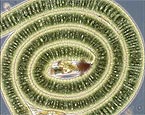The 10-year Census of Marine Life has discovered huge numbers of previously unknown microbes, zooplankton, crustaceans, worms, and other small species, astonishing scientists with the sheer number of life forms that make up the lower orders of the marine food chain. Scientists estimate that as many as a billion different marine microbe species may exist, forming a biomass so vast that its weight equals that of 240 billion African elephants. Among the major discoveries of the census was the existence of large, whitish mats on the sea floor formed by multi-cellular bacteria that resemble thin strands of spaghetti. One such mat — roughly the size of Greece — was found in oxygen-starved Pacific waters off the coasts of Chile and Peru. “In no other realm of sea life has the magnitude of Census discovery been as extensive as in the world of microbes,” said Mitch Sogin, a scientist from the Marine Biological Laboratory in Woods Hole, Mass. who heads the marine microbe census.
Countless Microbe Species Discovered in Census of Marine Life
More From E360
-
ANALYSIS
As U.S. and E.U. Retreat on Climate, China Takes the Leadership Role
-
Solutions
From Ruins to Reuse: How Ukrainians Are Repurposing War Waste
-
ANALYSIS
Carbon Offsets Are Failing. Can a New Plan Save the Rainforests?
-
Energy
Facing a Hostile Administration, U.S. Offshore Wind Is in Retreat
-
Biodiversity
As Jaguars Recover, Will the Border Wall Block Their U.S. Return?
-
WATER
An E.U. Plan to Slash Micropollutants in Wastewater Is Under Attack
-
INTERVIEW
This Data Scientist Sees Progress in the Climate Change Fight
-
Climate
As Floods Worsen, Pakistan Is the Epicenter of Climate Change
-
Climate
Heat Stress Is a Major Driver of India’s Kidney Disease Epidemic
-
Energy
It’s a ‘Golden Age’ for U.S. LNG Industry, But Climate Risks Loom
-
Climate
How Climate Risks Are Putting Home Insurance Out of Reach
-
INTERVIEW
Inside the Plastics Industry Playbook: Delay, Deny, and Distract
